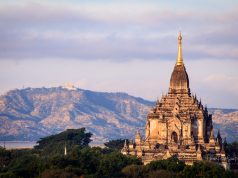Once again Thadingyut festival is just around the corner. Thadingyut is the seventh month of the Myanmar calander and the end of the Buddhist Lent. There is a well-known fact as Myanmar people have a penchant for festivals, Myanmar have festivals all around the year, at least one in each month of the year. Myanmar is rich in culture and has developed its own distinc- tive culture. Buddhism has great influence on the daily lives of Myanmar people and the celebration of light festival of Myanmar, the Thadingyut, happen at the end of the Buddhist lent. Thitin or thadin means Sila, a religious duty and kyut or gyut, to be freed or exonerated. For the whole three rainy month, beginning from the Full Moon day of Waso (June), the monks have been observ- ing the lent by staying where they happened to be on the commencement of the lent. Thadingyut festival is related to the descent of Buddha from heaven after he preached the Abidhama (the most difficult of Bud- dhist teaching) to his mother reborn in heaven for three lenten months. Just as a signature of welcoming back, Buddhist peo- ple all over the country, light candles when Lord Buddha and his disciples descended from heaven. Buddhists celebrate Thadin- gyut to welcome the Buddha and his disciples by enlightening and festooning the streets, houses and public buildings with colored electric bulbs or candles, which rep- resent those three stairways. At the pagodas the royalty rubbed shoulders with the peo- ple in their offering of lights. Men of means would make “a thousand lights offering” not of paraffin candles, but of earthen cups filled with oil and ginned cotton wicks. Most of the people use electric lights to illuminate. The Thadingyut, the Lighting Festival of Myanmar, is the second most popular fes- tival in Myanmar after Thingyan Festival (New Year Water Festival). There are three days of celebrating it as a custom, namely the day before full moon, the full moon day and the day after.
During Thadingyut festival, there are a variety activities for everyone to enjoy. Every corner of the street, there are free shows , Zat Pwes (Myanmar musical plays), stage shows, etc. We also can see a lot of food- stalls, which sell a variety of Myanmar traditional foods and shops, toys, kitchen utensils and other useful stuffs on almost every streets. It is quite usual for people just walk around in those streets just for sightseeing and have fun while their hang- ing out with friends. Buddhists usually go to pagodas such as the famous Shwedagon, city-centered Sule Pagoda, Botahtaung Pa- goda. Some go to monasteries to pay respect to the monks and fast on the full moon day. October, end of Buddhist lent is also a month for weddings in Myanmar. During three Lent months, getting married is a taboo. Marriages not consummated prior to the Full Moon Day of Waso have to be postponed till the end of the lent. Young lovers can now tie the knot and celebrate their wedding ceremonies grandly among their communities. We can see a lot of love birds preparing and daydreaming for their elegant wedding ceremony around Thadin- gyut. Last but not least, it is a time for remem- bering those to whom we owe respect and gratitude. Thadingyut is not only for joy but also a season of remembering. It is also a time for remembering those to whom we owe respect and paying homage to Buddhist monks. Young people can be seen walking with candles and gifts in their hands such as some fruits, foods and other gifts to paying respect (kadaw) to teachers, parents and el- ders relatives and asking pardon for whatever misdeeds might have committed during the year. Sometimes it is an organized affair, but this does not prevent them from going to older people individually to pay respect. The word “kadaw” is synonymous with “sorry’, but with a deeper feelings on such occasion. Additionally, the elder ones wish good luck for them and give them some pocket money in return. We can vividly see Thadingyut season spirit in which paying respects to these to whom respect is due and remembering those to whom we owe gratitude.










